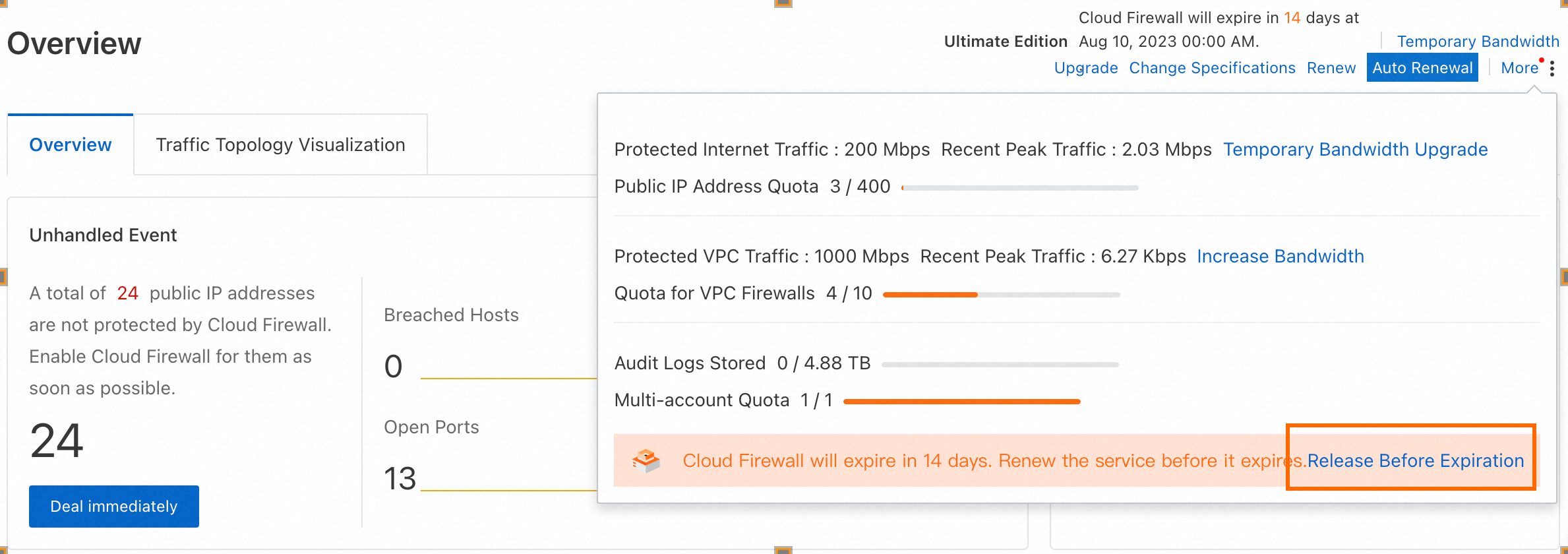If you no longer want to use Cloud Firewall to protect your assets, you can release Cloud Firewall to avoid additional costs. This topic describes how to release Cloud Firewall and the impacts on your business after the release.
After you release Cloud Firewall, Cloud Firewall no longer protects your network assets, and the policies that you configure become invalid. In this case, your assets may be attacked. We recommend that you release Cloud Firewall during off-peak hours. Before you release Cloud Firewall, make sure that your business runs as expected.
Precautions
Item | Subscription (Premium Edition, Enterprise Edition, and Ultimate Edition) | Pay-as-you-go |
Refund | If you release Cloud Firewall before expiration, you cannot request a refund. | After you release Cloud Firewall, the billing immediately stops. Bills of Cloud Firewall that uses the pay-as-you-go billing method are generated on Day T+1. You can receive bills on Day T+1 after you release Cloud Firewall. |
Configure data retention | After you release Cloud Firewall, the system retains your configuration data for seven days. The configuration data includes access control policies, attack prevention policies, and traffic analysis policies. This allows you to continue using the configuration data if you renew or purchase Cloud Firewall within seven days. Log analysis statistics are not retained. | After you release Cloud Firewall, the system retains your configuration data for seven days. The configuration data includes access control policies, attack prevention policies, and traffic analysis policies. This allows you to continue using the configuration data if you reactivate Cloud Firewall within seven days. |
Subscription
Release methods
Cloud Firewall that uses the subscription billing method supports automatic release and manual release.
Automatic release
If your subscription to Cloud Firewall expires, Cloud Firewall no longer provides protection for your assets and is automatically released after 15 days. If you renew your subscription before the automatic release, Cloud Firewall is not released. For more information about how to renew your subscription to Cloud Firewall, see Renewal.
Manual release
You can manually release Cloud Firewall in the period from 15 days before your subscription expires to 7 days after your subscription expires.
Manually release Cloud Firewall that uses the subscription billing method
If you manually release Cloud Firewall that uses the subscription billing method before the expiration time, no refund is provided.
Prerequisites
Before you manually release Cloud Firewall that uses the subscription billing method and runs Enterprise Edition or Ultimate Edition, you must disable virtual private cloud (VPC) firewalls. For more information, see Configure a VPC firewall for an Enterprise Edition transit router.
Procedure
Log on to the Cloud Firewall console. In the upper-right corner of the Overview page, choose .

Pay-as-you-go
If you no longer require Cloud Firewall that uses the pay-as-you-go billing method, you can perform the following operations to release it: Log on to the Cloud Firewall console. In the upper-right corner of the Overview page, click Self-service Release.

References
How do I view the usage details of Cloud Firewall that uses the pay-as-you-go billing method?
The refund methods and refund policies for related resources vary based on the billing method. For more information, see Self-service unsubscription and release.
If you want to continue using Cloud Firewall, you can purchase Cloud Firewall again. For more information, see Purchase Cloud Firewall.
